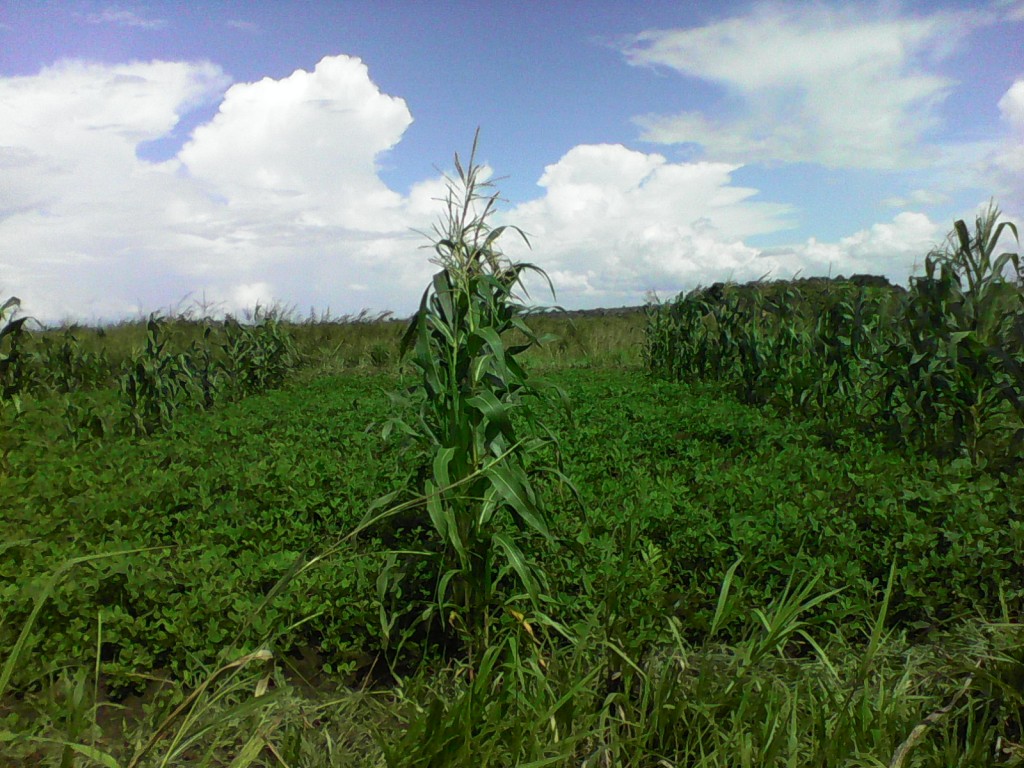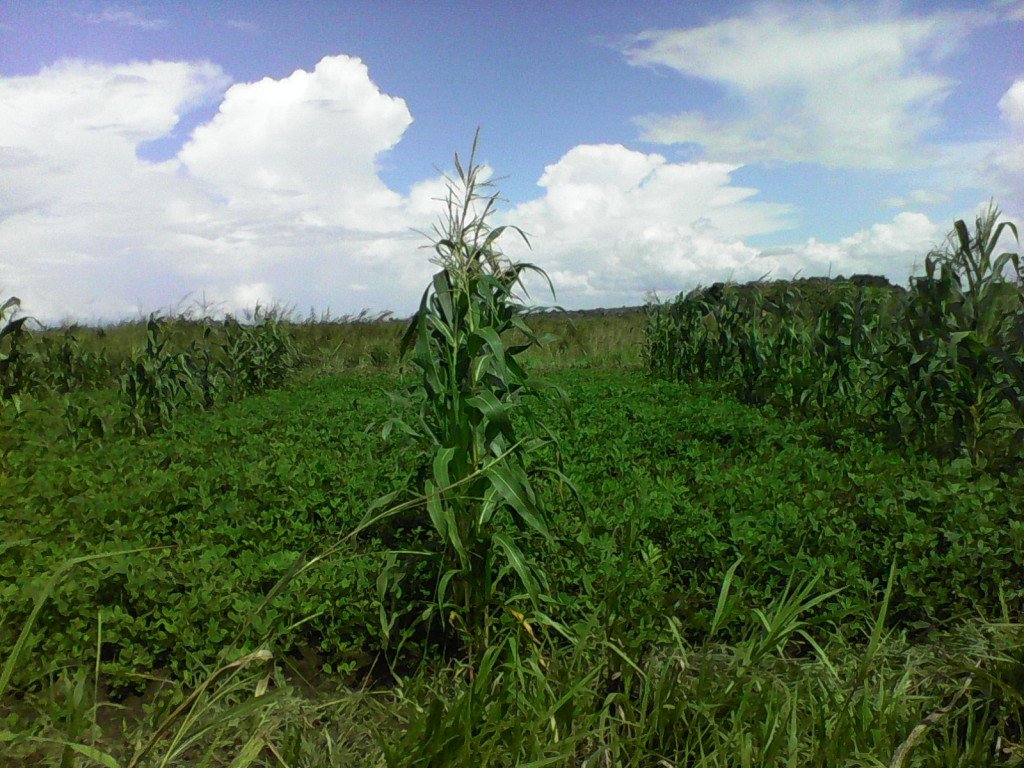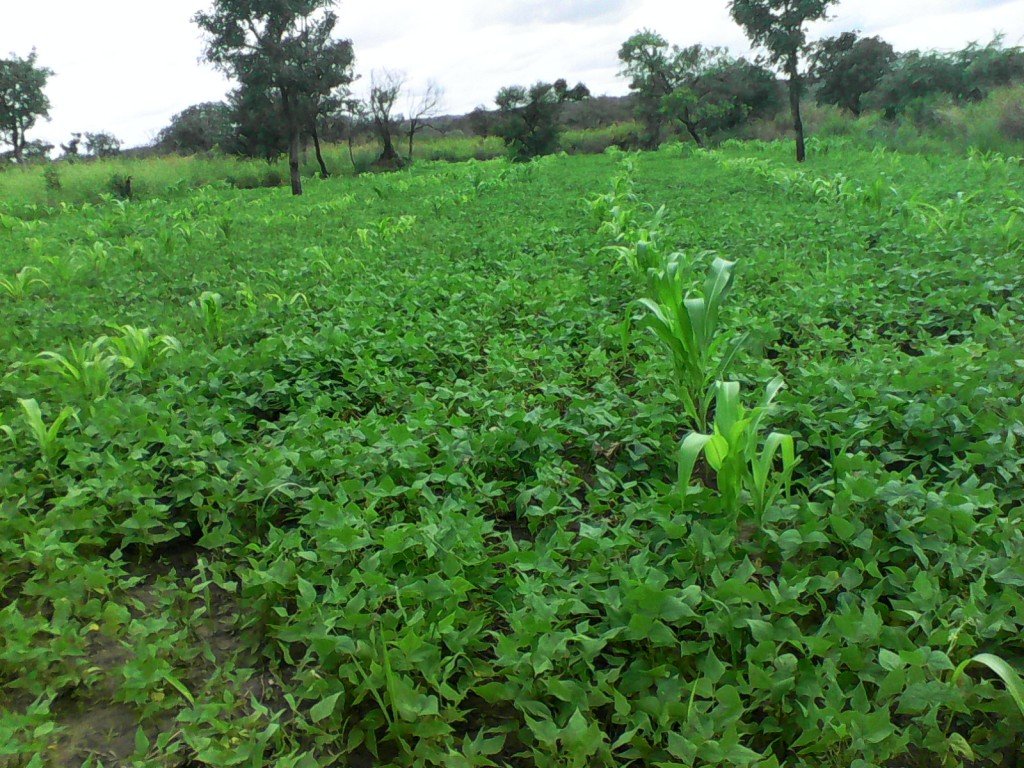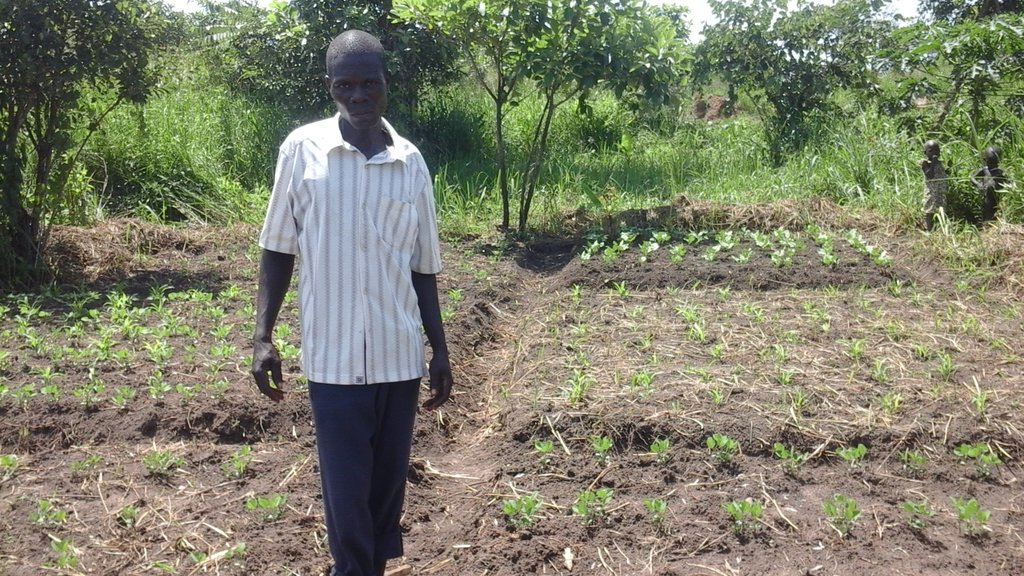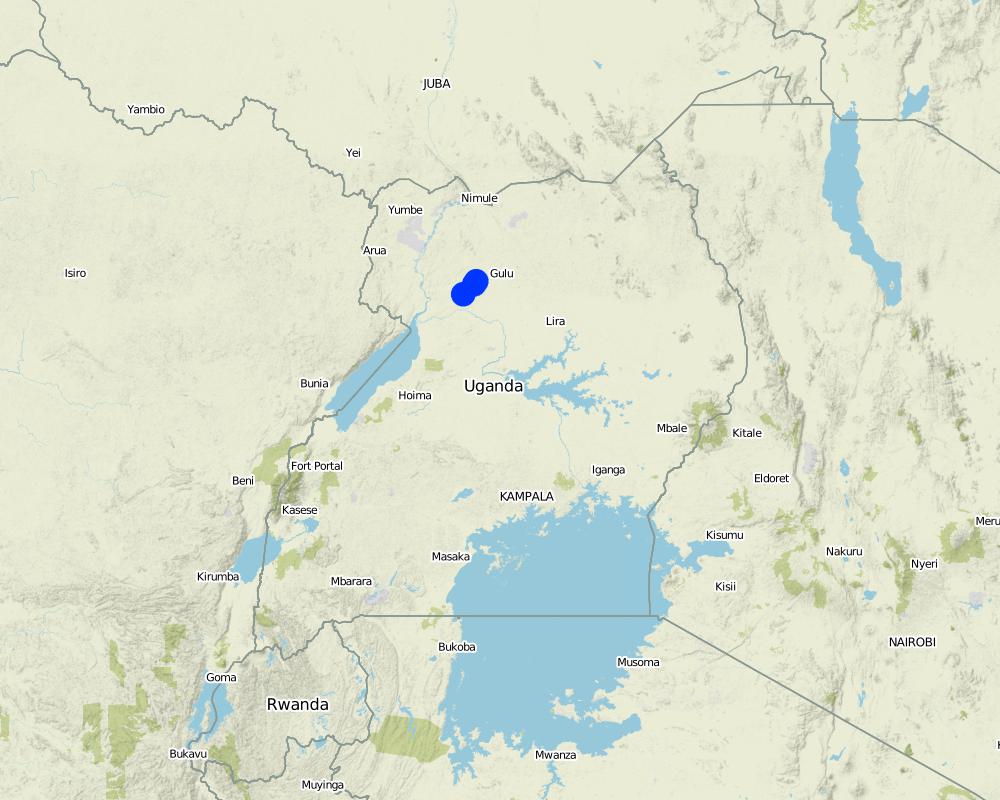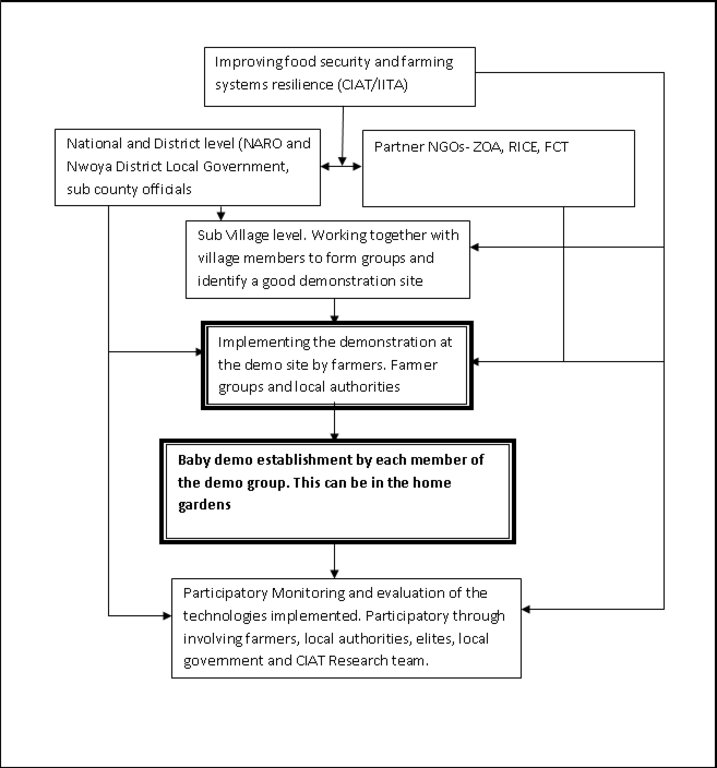Promoting intercropping through baby demos [乌干达]
- 创建:
- 更新:
- 编制者: Sunday Balla Amale
- 编辑者: –
- 审查者: John Stephen Tenywa, Nicole Harari
poto matino
approaches_3327 - 乌干达
查看章节
全部展开 全部收起1. 一般信息
1.2 参与方法评估和文件编制的资源人员和机构的联系方式
关键资源人员
土地使用者:
okello Martin
Local Farmer
Oporlacen-Olwiyo, Purongo Sub-county, Nwoya District
乌干达
有助于对方法进行记录/评估的项目名称(如相关)
Scaling-up SLM practices by smallholder farmers (IFAD)有助于对方法进行记录/评估的机构名称(如相关)
Uganda Landcare Network (ULN) - 乌干达1.3 关于使用通过WOCAT记录的数据的条件
(现场)数据是什么时候汇编的?:
12/12/2017
编制者和关键资源人员接受有关使用通过WOCAT记录数据的条件。:
是
2. SLM方法的描述
2.1 该方法的简要说明
A demonstration site is established where farmers come and learn about good intercropping practices. They are then tasked to replicate this practice at their homes in the baby demos.
2.2 该方法的详细说明
该方法的详细说明:
The baby demo approach involves establishing a mother demo in one location where members of the farmer group can come and learn about the technology of interest (intercropping in this case). The farmers who participate in the demo are then tasked to replicate what is carried out in the demo by establishing smaller baby demos at their homes so that whatever is performed in the mother demo, they transfer the knowledge to their own baby demos. This helps to take the ideas in the demonstration to the farmers' homes so that they can appreciate what is being done on the demo and own the technology being implemented.
This approach was promoted because most farmers in northern Uganda practice inappropriate intercropping methods where they plant together two cereals in the same garden and call it an inter crop e.g maize and rice or millet and sorghum. Baby demo helps the farmers to know that they can implement the practices on their own hence increasing sustainability of the approach. It also helps neighbours and family members who are not participating in the demonstration activities to learn from the baby demo.
During the project activities, a demonstration site was identified in collaboration with the farmer group, a field was established by the group members consisting of 35 people on average (composed of men, women and youth). The demo area measured about 10m x 10m. Each participant was then given a handful of seeds to go and establish their demo of approximately 8m2 on estimate.
The farmers then implemented the demo and baby demos with intercropping of maize and beans. Joint monitoring and evaluation was later carried out.
2.3 该方法的照片
2.5 采用该方法的国家/地区/地点
国家:
乌干达
区域/州/省:
Northern Uganda
有关地点的进一步说明:
Alero, Koch Goma, Anaka and Purongo Sub-County, Nwoya District
Map
×2.6 该方法的开始和终止日期
注明开始年份:
2014
若不知道准确的年份,请注明该方法的大致开始日期。:
不到10年前(最近)
终止年份(若不再采用该方法):
2017
注释:
three years project
2.7 方法的类型
- 基于项目/方案
2.8 该方法的主要目的/目标
improving farming systems resilience, farmers appreciation of the technology within their own farms
2.9 推动或妨碍实施本办法所适用的技术的条件
社会/文化/宗教规范和价值观
- 启动
community group membership
机构设置
- 启动
good institutional framework
参与者的的协作/协调
- 启动
more than 3 parties involving government and non governmental, local farmers
政策
- 启动
PMA-Plan for Modernisation of Agriculture, a Government policy aimed at ensuring adoption of modern farming technologies
Vision 2040-A government policy aims at transforming uganda's agriculture from subsistence to commercial farming.
了解SLM,获得技术支持
- 启动
various agencies,
市场(购买投入,销售产品)和价格
- 启动
good market access and transport network
- 阻碍
middle men cheating producers
3. 相关利益相关者的参与和角色
3.1 该方法涉及的利益相关者及其职责
- 当地土地使用者/当地社区
farmers
implementing the demo
- 社区组织
farmer groups, Village Saving and Loan Association (VSLA) groups
work as a team at the demo
- SLM专家/农业顾问
District Agriculture/extension officers,
organise farmers
- 研究人员
CIAT
Monitoring and evation output, analysis of effectiveness of the method
- 教师/学龄儿童/学生
teachers
part of farmer groups
- NGO
ZOA, Rural Initiative for community Empowerment (RICE), Forum for comunity transformation (FCT)
Participatory monitoring and evaluation (PME)
- 私营部门
business community
PME
- 地方政府
District, sub county and parish officials
liase with local communities, PME
- 国家政府(规划者、决策者)
NARO -
Policy framework analysis
- 国际组织
IFAD, CIAT, IITA, ZOA-
initiation, planning, implementation, monitoring and evaluation of the project activities
如果涉及多个利益相关者,请注明领导机构:
CIAT
3.2 当地土地使用者/当地社区参与该方法的不同阶段
| 当地土地使用者/当地社区的参与 | 指定参与人员并描述活动 | |
|---|---|---|
| 启动/动机 | 外部支持 | CIAT-draft of project for increasing food security and farming systems resilience in East Africa through wide scale adoption of Climate Smart Agricultural Practices |
| 计划 | 外部支持 | CIAT/IITA/IFAD-establishment of objecttives, sourcing of funds. |
| 实施 | 互动 | farmer groups formed, then they implement the demo at demo site and baby demos at their own homes. Stakeholders at village, sub-county, district and national levels also involved. |
| 监测/评估 | 互动 | Participatory monitoring and evaluation where farmers were able to rank the performance of their crops under the demo and baby demos, challenges, and possible solutions. |
3.3 流程图(如可用)
3.4 有关SLM技术选择的决策
具体说明谁有权决定选择要实施的技术:
- 所有相关参与者,作为参与式方法的一部分
解释:
Rappid appraisal with farmers to establish the needs of the farmers
明确做出决策的依据:
- 对充分记录的SLM知识进行评估(基于证据的决策)
4. 技术支持、能力建设和知识管理
4.1 能力建设/培训
是否为土地使用者/其他利益相关者提供培训?:
是
明确受训人员:
- 土地使用者
如果相关,请说明性别、年龄、地位、种族等。:
all gender, age group and people of different status quo
培训形式:
- 示范区域
涵盖的主题:
intercropping with legumes and cereals
4.2 咨询服务
土地使用者有权使用咨询服务吗?:
是
指明是否提供了咨询服务:
- 在土地使用者的土地上
4.3 机构强化(组织发展)
是否通过这种方法建立或加强了机构?:
- 是,适度
具体说明机构的强化或建立程度:
- 本地
说明机构、角色和职责、成员等。:
Farmer groups for implementation of of technology, involvement of different age groups and gender in the implementation of technologies.
具体说明支持类型:
- 能力建设/培训
4.4 监测和评估
监测和评估是该方法的一部分吗?:
是
注释:
Participatory Monitoring and evaluation (PME)
若是,该文件是否用于监测和评估?:
否
4.5 研究
研究是该方法的一部分吗?
是
明确话题:
- 技术
提供进一步的细节,并指出是谁做的研究:
CIAT based research output
5. 融资和外部物质支持
5.1 该方法中SLM组成部分的年度预算
如果不知道准确的年度预算,请给出一个范围:
- 2,000-10,000
注释(例如主要的资助来源/主要捐助者):
IFAD funded. 5 different demonstration groups were considered, one in each of the sub-county. Actual implementation cost could be obtained from CIAT.
5.2 为土地使用者提供财政/物质支援
土地使用者是否获得实施该技术的财政/物质支持?:
否
5.3 对特定投入的补贴(包括劳动力)
- 农业
| 具体说明哪些投入得到了补贴 | 程度如何 | 对补贴做出具体说明 |
|---|---|---|
| 种子 | 部分融资 | handful of seed for the baby demo |
如果土地使用者的劳动力是一项重要的投入,那么是不是:
- 自愿
注释:
farmers worked in groups
5.4 信用
是否根据SLM活动的方法给予信用值?:
否
5.5 其它激励或手段
是否有其他激励措施或工具用于促进SLM技术的实施?:
是
如果是,请具体说明:
refreshments during demonstration activities
6. 影响分析和结论性陈述
6.1 方法的影响
该方法是否有助于当地土地使用者,提高利益相关者的参与度?:
- 否
- 是,很少
- 是,中等
- 是,支持力度很大
made participatory
这种方法是否有助于基于证据的决策?:
- 否
- 是,很少
- 是,中等
- 是,支持力度很大
farmers selected what should be implemented
该方法是否帮助土地使用者实施和维护SLM技术?:
- 否
- 是,很少
- 是,中等
- 是,支持力度很大
implemented in their own gardens in the baby demos
该方法是否提高了SLM的协调性和成本效益?:
- 否
- 是,很少
- 是,中等
- 是,支持力度很大
other farmers not able to be part of the demo learn from the baby demos
该方法是否调动/改善了使用财务资源实施SLM的途径?:
- 否
- 是,很少
- 是,中等
- 是,支持力度很大
directed towards technology transfer
该方法是否提高了土地使用者实施土地管理的知识和能力?:
- 否
- 是,很少
- 是,中等
- 是,支持力度很大
obtained training from the demo, then able to implement in their farms
该方法是否提高了其他利益相关者的知识和能力?:
- 否
- 是,很少
- 是,中等
- 是,支持力度很大
through PME
该方法是否建立/加强了机构、利益相关者之间的合作?:
- 否
- 是,很少
- 是,中等
- 是,支持力度很大
many institutions involed
该方法是否缓解了冲突?:
- 否
- 是,很少
- 是,中等
- 是,支持力度很大
group membership and social relations in the demos
该方法是否有助于社会和经济弱势群体?:
- 否
- 是,很少
- 是,中等
- 是,支持力度很大
voluntary participation involving all categories of people
该方法是否改善了性别平等并赋予女性权力?:
- 否
- 是,很少
- 是,中等
- 是,支持力度很大
all gender equally participated, disadvanteaged women were highly encouraged to be part
该方法是否鼓励年轻人/下一代土地使用者参与SLM?:
- 否
- 是,很少
- 是,中等
- 是,支持力度很大
youth involved
该方法是否改善了阻碍SLM技术实施的土地使用权/用户权问题?:
- 否
- 是,很少
- 是,中等
- 是,支持力度很大
not part of objective
该方法是否改善了粮食安全/改善了营养?:
- 否
- 是,很少
- 是,中等
- 是,支持力度很大
better farm output as a result of the technology
该方法是否改善了市场准入?:
- 否
- 是,很少
- 是,中等
- 是,支持力度很大
marketing skills were taught
该方法是否改善了供水和卫生条件?:
- 否
- 是,很少
- 是,中等
- 是,支持力度很大
not part of the objective
no part of the objective
该方法是否提高了土地使用者适应气候变化/极端情况和减轻气候相关灾害的能力?:
- 否
- 是,很少
- 是,中等
- 是,支持力度很大
technology is specifically CSA practice
该方法是否会带来就业、收入机会?:
- 否
- 是,很少
- 是,中等
- 是,支持力度很大
to field staff
6.2 土地使用者实施SLM的主要动机
- 增加生产
higher yields
- 增加利润(能力),提高成本效益比
more produce
- 减少土地退化
intercrop maintains soil fertility
- 降低灾害风险
intercrop functions such as reduced erosion, reduce crop failures
- 减少工作量
easy management
- 加入运动/项目/团体/网络
group membership. people from one group worked hard to ensure good output from their demo
- 提高SLM知识和技能
trainings provided to farmers
6.3 方法活动的可持续性
土地使用者能否维持通过该方法实施的措施(无外部支持的情况下)?:
- 是
若是,请说明如何维持:
simple and easy
6.4 该方法的长处/优点
| 土地使用者眼中的长处/优势/机会 |
|---|
| Farmers appreciate the technology from within their homestead |
| Other neighboring farmers or family members who did not participate in the demo can learn from the baby demo |
| Farmer can easily reflect on the demo and compare with his baby demo |
| 编制者或其他关键资源人员认为的长处/优势/机会 |
|---|
| Knowledge spillover has a wider coverage as people who did not get opportunity to participate in the main demo would learn from their neighbors. |
| Project can be sustained for a longer period since the farmers can be tasked to do the baby demo in the following years. |
6.5 该方法的弱点/缺点以及克服它们的方法
| 土地使用者认为的弱点/缺点/风险 | 如何克服它们? |
|---|---|
| Farmer overlook the importance of baby demos saying it looks like children playing garden. | establish a sizeable baby demo |
| Domestic animals eat the crops in the baby demos. | control the animals |
7. 参考和链接
7.1 方法/信息来源
- 实地考察、实地调查
1
- 与土地使用者的访谈
10
- 与SLM专业人员/专家的访谈
2
链接和模块
全部展开 全部收起链接
无链接
模块
无模块


